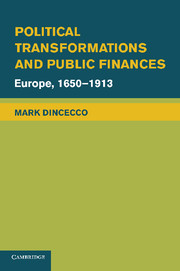Book contents
- Frontmatter
- Contents
- Figures and Tables
- Acknowledgments
- 1 Weak and Strong States in Historical Perspective
- 2 Gaining Force
- 3 Restricting Power
- 4 Political Regimes and Credit Risk
- 5 Two Mechanisms
- 6 Letting the Data Speak for Themselves
- 7 Estimating the Fiscal Effects of Political Regimes
- 8 The Institutional Balance of Modern Fiscal States
- Appendices
- Works Cited
- Index
8 - The Institutional Balance of Modern Fiscal States
Published online by Cambridge University Press: 07 October 2011
- Frontmatter
- Contents
- Figures and Tables
- Acknowledgments
- 1 Weak and Strong States in Historical Perspective
- 2 Gaining Force
- 3 Restricting Power
- 4 Political Regimes and Credit Risk
- 5 Two Mechanisms
- 6 Letting the Data Speak for Themselves
- 7 Estimating the Fiscal Effects of Political Regimes
- 8 The Institutional Balance of Modern Fiscal States
- Appendices
- Works Cited
- Index
Summary
The qualitative and quantitative investigation performed in this book strongly indicates that political transformations had profound fiscal effects. The main findings are now assessed in light of the previous literature. The analysis then concludes by examining how political transformations changed the ways in which states spent public funds and by drawing historical lessons for today’s emerging and advanced economies.
Assessment of Findings
Chapters 2 and 3 characterized the two fundamental political transformations that European states experienced in the past. Most Old Regime states were fiscally fragmented, or weak, in 1650. Local tax free-riding reduced the ability of national governments to gather revenues. Fiscal centralization, which generally took place after the fall of the Old Regime at the end of the eighteenth century, was the first fundamental political transformation that states underwent. However, the consolidation of fiscal powers may have exacerbated problems of executive control. Since strong rulers could still use government funds as they pleased, spending constraints were necessary. The establishment of parliamentary limits, which typically occurred during the nineteenth century, was the second fundamental political transformation that states experienced. By the eve of World War I in 1913, European states could gather large tax revenues, and rulers faced parliamentary spending constraints. The end result was a set of balanced fiscal and political institutions of the sort that characterizes modern systems of public finance in wealthy countries.
- Type
- Chapter
- Information
- Political Transformations and Public FinancesEurope, 1650–1913, pp. 108 - 120Publisher: Cambridge University PressPrint publication year: 2011

